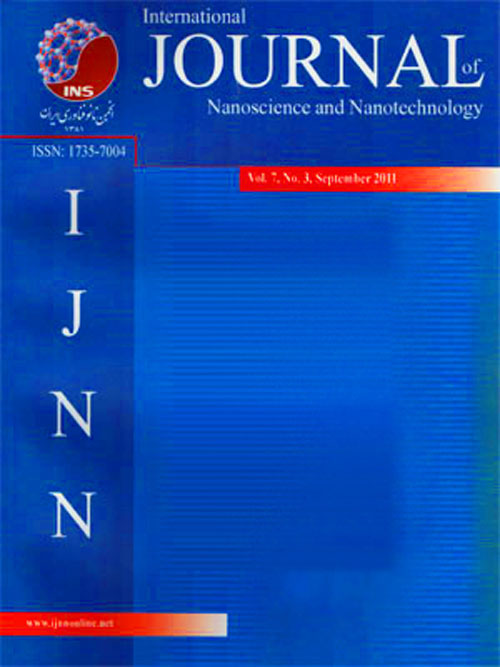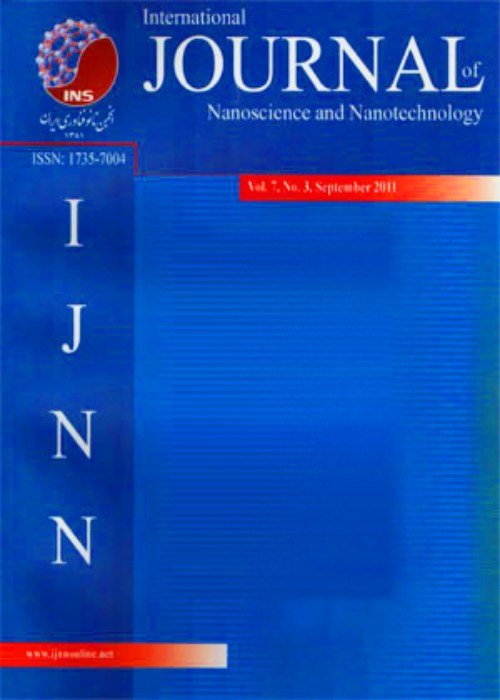فهرست مطالب

International Journal Of Nanoscience and Nanotechnology
Volume:15 Issue: 3, Summer 2019
- تاریخ انتشار: 1398/05/10
- تعداد عناوین: 6
-
-
Pages 145-155The potential for nanofuels as one of the clean sources of energy on account of its enhanced combustion performance coupled with low emissions has been established. Considering the importance of the fuel evaporation phase in the entire combustion process, this work presents an attempt at applying the steady state analysis equations to nanofuel experimental data obtained from the literature in droplet evaporation analysis. The evaporation parameters considered included the rate, constant value (k), the droplet lifetime as well as the D2 Law response. The extent of applicability of the steady state analysis model equations to nanofuel droplet evaporation was investigated using nanofuel experimental data consisting of ethanol and alumina nanoparticles as well as n-decane and alumina nanoparticles with particle concentration ranging from 0.5-2.5%. The evaporation rate was found to decrease with increasing nanoparticle addition while the droplet lifetime increased marginally, thus validating experimentally obtained result. The nanoparticle inclusion had no effect on the evaporation rate constant value (k) as it remained unchanged throughout the droplet evaporation progression, thus showing adherence to the Classical D2 Law.Keywords: D2 Law, Droplet evaporation, Evaporation rate, Nanofuels.
-
Pages 157-177Novel lipid nanoparticulates (NCs) were developed by a combined approach of precipitation and complexation with an aim to improve the solubility, stability and targeting efficiency of glimepiride (GLP). GLP NCs were prepared by precipitation process using PEG 20000 and further complexed with phospholipon90G (P90G). The NCs were evaluated for physicochemical characterization, such as drug loading, saturation solubility (SS) and particle characterization studies. The solid state characterization studies were performed using X-ray powder diffractometry (XRPD), differential scanning calorimetry (DSC), infrared spectroscopy (FTIR) and scanning electron microscopy (SEM). Further in-vitro dissolution studies and in vivo (drug targeting) studies were also performed. Short term (3 months) stability studies were conducted on most satisfactory NCs. GLP P90G NCs exhibited three folds increase in saturation solubility. Particle size of NCs was ranging from between 210-240 nm. The dissolution and in vitro stability of NCs were superior compared to pure GLP. XRPD and DSC analysis proved that crystallinity prevailed in NCs, but with a slight change in crystal structure. SEM analysis indicated spherical shaped particles with a lipid coat. The NCs were found to be stable during the period of study. In vivo studies on optimized NCs showed slightly higher drug concentration (1.38 µg/ml) in pancreas of rat than that of pure GLP. It can be concluded that solubility and stability of GLPNCs were significantly improved by P90G complexation. Also, P90G (phospholipids) could be effectively used in enhancing the targeting efficiency and pharmacokinetics of glimepiride.Keywords: nanoparticles, Nanonization, phospholipids, pancreatic targeting, Surface properties.
-
Pages 179-188In this study, we report the green synthesis of silver nanoparticles (AgNPs) from extracts of native fruits from Amazonia, Brazil. AgNPs were characterized by UV/Vis and medium infrared (MIR) spectroscopy. Their antimicrobial activities were evaluated against the growth of bacteria and leavers, as well as the evaluation of minimum inhibitory concentration (MIC) and minimum bactericidal concentration (MBC). The colloidal solutions had a maximum absorption peak around 440 nm, as was well reported in the literature for colloidal silver. The MIR spectra identified the functional groups of carboxylic acids and several phenolic compounds as possible factors responsible for the stabilization and coating of AgNPs. All synthesized AgNPs showed antimicrobial activity against Candida albicans, Escherichia coli and Staphylococcus aureus. In this sense, the obtained results showed that the native plants of Amazonia have potential to be used for the green synthesis of AgNPs and that more studies related to their applications should be performed.Keywords: Antimicrobial activity, Minimal Inhibitory Concentration, Minimum bactericidal concentration, AgNPs.
-
Pages 189-198We report the efficacy of the silver nanoparticles (AgNPs) synthesized using the leaf and bark extracts of Syzygium cumini (common name Jamun) with silver nitrate (AgNO3)which were used as both reducing and capping agent at varied temperatures- 25°C, 37°C and 80°C. Three sets of AgNPs from leaf and bark extracts, were synthesized at the above mentioned temperatures, and then physical characterization using UV-Vis spectroscopy indicated a peak in the range of 385-460nm. The hydrodynamic radii measured by DLS clearly indicated the size of AgNPs in the range of 72-284nm. The biological efficacy in terms of antimicrobial activity was assessed by Kirby Bauer method, applied for both Gram positive and Gram negative bacteria such as Staphylococcus aureus and Escherchia coli respectively. The Zone of inhibition (ZOI) diameter was found to be 22mm and 20mm in S.aureus and E.coli, indicated the bactericidal activity of AgNPs synthesized from leaf extract at 25°C was maximum. Further, the IC50 of the same AgNP was 12.5µg/ml indicating 49.3% cytotoxicity in human breast adenocarcinoma cell line MCF-7 confirmed the anticancer activity, whereas in HEK cell line the cyototoxicity observed was only 8.95% at the same concentration. The upregulation of apoptotic marker “p53” post treatment with 12.5µg/ml for 24hrs as done by Western blotting. Hence, AgNPs synthesized by green synthesis are proposed as economical, environment friendly having immense potential for drug delivery.Keywords: Anticancer, Antimicrobial, Apoptosis, Green Chemistry, Silver nanoparticles, Syzygium cumini.
-
Pages 199-210This research studies the application of essential oil nanoemulsion as herbal medicine instead of using antibiotics and chemicals. Thyme, shirazi thyme and rosemary essential oils were selected as herbal drugs. Essential oil nanoemulsions with Tween 80 and/or Sodium dodecyl sulfate (SDS) surfactants were prepared and investigated. Physicochemical characterizations such as hydrodynamic diameter, pH, conductivity, optical clarity and antibacterial activity against gram negative bacteria, E.coli, have been studied. Morphology of the nanoemulsions was evaluated by transmission electron microscope (TEM). Nanoemulsions prepared with the mixture of SDS−Tween 80 had particle diameters significantly smaller than those prepared with Tween 80 (2-11.7 nm in comparison with 189-200 nm). Formulated nanoemulsions had long-term stability at ambient temperature; as there were little changes in droplet diameter after storage for 2 months. MTT assay showed non-toxicity of prepared nanoemulsions. Antibacterial activity against E.coli was also studied by counting the number of survival bacteria in a broth medium. The in vitro test indicated efficacy of all prepared emulsions on E.coli, especially those containing thyme essential oil. The results suggested that the formulated nanoemulsions might be used as potential carrier in food, pharmaceutical and drug delivery systems.Keywords: Nanoemulsion, Thyme oil, Rosemary oil, MTT assay, In vitro test.
-
Pages 211-217This paper presents a novel design of quaternary logic gates using graphene nanoribbon field effect transistors (GNRFETs). GNRFETs are the alternative devices for digital circuit design due to their superior carrier-transport properties and potential for large-scale processing. In addition, Multiple-valued logic (MVL) is a promising alternative to the conventional binary logic design. Saving power and reduced chip area is the reason for simplicity. The first design is a resistive-load GNRFET-based quaternary inverter gate. The channel length is 15 nm. This circuit works with a 0.9V supply voltage at room temperature. For optimizing the first design, resistors are replaced with transistors in the second design. Simulation results using HSPICE indicate that in the second proposed design provides 61.1% reduction in power-delay product (PDP) that of first proposed. These results can be used in MVL design based on nano devices.Keywords: GNRFET, Inverter, Multiple-valued design, Power-delay product (PDP), Quaternary.


